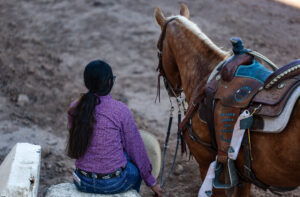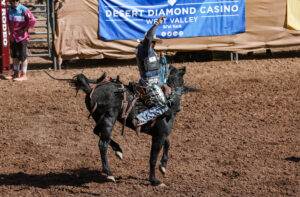- Slug: Native American Rodeo. 1,110 words.
- Photos available (thumbnails, captions below).
By Marshall Baker
Cronkite News
PHOENIX – The Arizona State Fair is one of Arizona’s longest-standing traditions, dating back almost 30 years before statehood. Starting all the way back in 1884, it’s one of the largest fairs in the United States, bringing in over 1.4 million visitors in 2023.
The Native American Rodeo is part of the rich tradition of the fair, with spectators and competitors from tribal nations across the country. It celebrates the Indigenous peoples who heavily influenced the history of Arizona. It is one of the most popular events among Indigenous communities at the fair, but there are questions surrounding their involvement with all aspects of the rodeo.
“I think to bring back some of the Native culture that we don’t have like we used to, I think that would be good,” said Jerry Honeycutt of Honeycutt Rodeo Company. He is a third-generation stock contractor, and his family has been working with the State Fair as long as he can remember. “My grandpa, Walt Alsbaugh, was at this rodeo many, many years ago. He started in the ’40s, and I think his first Arizona State Fair was in the late ’50s. And our family has been here this long, providing the livestock for the rodeo.”
Honeycutt Rodeo, based in Alamosa, Colorado, is the sole stock contractor for the Native American Rodeo and is in charge of the production of the entire event – laying the dirt, bringing in the calves and bulls, even bringing in the rodeo clowns. However, it is not an Indigenous-led company.
In 2022, the Native American Rodeo was held with consultation from the Arizona Native American Rodeo Committee (AZNAR), an organization that was formed to work with State Fair officials.
A bill was introduced in the Arizona Senate by Sen. Theresa Hatathlie, D-Tuba City, in February 2023 that would’ve solidified the committee of five tribal members appointed by the governor to oversee and facilitate the rodeo. In addition to the committee, the bill would have established the Native American Rodeo Fund of $300,000 annually from the state general fund. The bill died in the Senate that year.
The AZNAR is no longer assisting in the rodeo, and not much is known about why the organization ended its involvement.
“We used to have all kinds of Native dancers and stuff, and that was pretty cool. … But that’s when the committee was there doing that, but I’m not sure what happened with the committee,” Honeycutt said. “And so that kind of went away, and then the fair just went back to the way it always is.”
The Arizona State Fair, AZNAR officials and Hatathlie did not respond to requests for comment.
In addition to the Indigenous dancers and singers, the rodeo also showcased Indigenous rodeo pageantry, a staple in Indigenous rodeos all across the country.
Rodeo pageantry blends traditional beauty pageants with rodeo competition. Contestants are judged on appearance, character and horsemanship skills. Winners earn the title of rodeo queen or princess and represent that rodeo as they travel throughout the country.
Indigenous rodeo pageantry operates similarly, but with many queens and princesses representing different tribal nations across the U.S. and Canada. Pageant contestants are also judged on elements different from regular pageantry competitions: language, traditional knowledge and traditional Indigenous skills. The Native American Rodeo has not held its own pageant but brought in Indigenous rodeo queens and princesses from across the country in the past.
Destinee Bigman is from the Phoenix area, and her family has been participating in the Native American Rodeo for years in calf roping and other events. “My family, we all do rodeo, so it’s a good, it’s an open rodeo, so we all can get in with each other,” Bigman said. “It’s more family-oriented, especially for team roping. I could rope with my brother. I can rope with my sister. My brothers can rope with my dad.”
Bigman said she thinks more could be done to include Indigenous people in all aspects of the rodeo. “’It’s something that we should push towards because I know a lot of Native American or Indigenous people that do a lot of stock contracting, and it’d be nice for them to come out here, too,” Bigman said.
The rodeo features eight events, including bareback riding, bull riding, team roping and ladies barrel racing, among others. The State Fair divides $16,000 among winners in each category, with additional prizes added. The open rodeo does not have any implications with the professional rodeo circuit or the Indian National Finals Rodeo.
The Indian National Finals Rodeo is the premier organization among tribal nations, with the INFR sanctioning nearly 700 events across the country. The finals for INFR are held in Las Vegas annually and is the single largest Indigenous rodeo in the U.S.
Dennison Boone is a member of the Navajo Nation from Mexican Springs, New Mexico, and is last year’s team roping champion at the INFR. He frequently participates in the Native American rodeo as he prepares for the INFR. “I try to come here every year,” Boone said. “It would be a lot better, I think, if they were really to come together and kind of put their heads together with different tribes coming here. … I think the grand stand would be packed every night.”
Montana Barlow is another competitor in the Native American Rodeo from the Navajo Nation in Rock Point. Barlow’s family has a long history at the rodeo, and he appreciates the community aspect as well as everything Honeycutt Rodeo Company has provided.
“This rodeo has always just been really good. It’s always really fun to be here, the carnival in the background, the nice committee, everyone’s always really good here,” Barlow said. “Jerry Honeycutt, and the rest of the family here, they all do a really good job for the rodeo. It’s been in their family all these years, ever since the rodeo has been going on, so they’ve always done a really good job with the livestock and everything.”
At the conclusion of the Native American Rodeo on Oct. 4 and 5, even without some of the elements the rodeo attendees have missed from previous years, it was still an important showcase of the rich rodeo culture and history within Indigenous communities in Arizona.
“I think it’s cool when everybody can come together for one purpose. And I think this country needs more of that,” Honeycutt said. “I don’t care what you look like, what color you are, we all got one purpose. We need to come together and make it happen. And at the rodeo, we all come together to make the best rodeo we can for the people that come to the fair.”
For more stories from Cronkite News, visit cronkitenews.azpbs.org.

